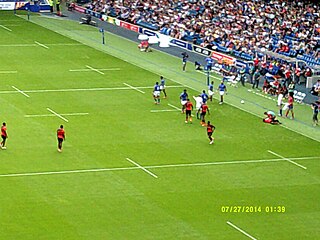
Papua New Guinea, officially the Independent State of Papua New Guinea, is a country in Oceania that comprises the eastern half of the island of New Guinea and its offshore islands in Melanesia. Its capital, located along its southeastern coast, is Port Moresby. It is the world's third largest island country with an area of 462,840 km2 (178,700 sq mi).

The economy of Papua New Guinea is largely underdeveloped. It is dominated by the agricultural, forestry, and fishing sector and the minerals and energy extraction sector. The agricultural, forestry, and fishing sector accounts for most of the labour force of Papua New Guinea, while the minerals and energy extraction sector is responsible for most of the export earnings.
The Sepik–Ramu languages are an obsolete language family of New Guinea linking the Sepik, Ramu, Nor–Pondo, Leonhard Schultze (Walio–Papi) and Yuat families, together with the Taiap language isolate, and proposed by Donald Laycock and John Z'graggen in 1975.

The Sepik or Sepik River languages are a family of some 50 Papuan languages spoken in the Sepik river basin of northern Papua New Guinea, proposed by Donald Laycock in 1965 in a somewhat more limited form than presented here. They tend to have simple phonologies, with few consonants or vowels and usually no tones.

The Kikori River is a major river in southern Papua New Guinea on the island of New Guinea. With a total length of 445 km (277 mi) long and flows southeast into the Gulf of Papua, with its delta at the head of the gulf. The settlement of Kikori lies on the delta.
The Ndu languages are the best known family of the Sepik languages of East Sepik Province in northern Papua New Guinea. Ndu is the word for 'man' in the languages that make up this group. The languages were first identified as a related family by Kirschbaum in 1922.

Bernard Mullu Narokobi was a Papua New Guinean politician, jurist, and philosopher. He was serving as the Papua New Guinean High Commissioner to New Zealand prior to his death. Between 1987 and 1997 he represented his Wewak Open Electorate as a Member in the Papua New Guinea's National Parliament. During his time as a Member of Parliament (MP), he served as the Minister for Justice (1988–1992) in the government led by the then Prime Minister Rabbie Namaliu; Agriculture Minister (1992–1994) under the leadership of Prime Minister Sir Julius Chan led government; and Opposition Leader between 1998 and 2002, and Speaker of the National Parliament of Papua New Guinea, until he lost his seat to the then Wewak MP Kimson Kare during the 2002 elections. He was displaced as a minister in the Chan government for failing to vote in favour of constitutional reforms in the provincial system of government.
Amal is a language spoken along the border of Sandaun Province and East Sepik Province, Papua New Guinea, along the Wagana River near the confluence with Wanibe Creek. Foley (2018) classifies Amal as a primary branch of the Sepik languages, though it is quite close to Kalou.

Papua New Guinea, a sovereign state in Oceania, is the most linguistically diverse country in the world. According to Ethnologue, there are 839 living languages spoken in the country. In 2006, Papua New Guinea Prime Minister Sir Michael Somare stated that "Papua New Guinea has 832 living languages ." Languages with statutory recognition are Tok Pisin, English, Hiri Motu, and Papua New Guinean Sign Language. Tok Pisin, an English-based creole, is the most widely spoken, serving as the country's lingua franca. Papua New Guinean Sign Language became the fourth officially recognised language in May 2015, and is used by the deaf population throughout the country.

France – Papua New Guinea relations refer to foreign relations between France and Papua New Guinea. Official diplomatic relations were established in 1976. France has an embassy in Port Moresby but Papua New Guinea has no diplomatic representation in France. Papua New Guinea's embassy in Brussels covers France.

New Guinea is the world's second-largest island, and with an area of 785,753 km2 (303,381 sq mi), the largest island in the Southern Hemisphere. Located in Melanesia in the southwestern Pacific Ocean, it is separated by the 150 km wide Torres Strait from Australia. Numerous smaller islands are located to the west and east. The eastern half of the island is the major land mass of the independent state of Papua New Guinea. The western half, known as Western New Guinea or West Papua, forms a part of Indonesia and is organized as the provinces of Papua and West Papua.

The Papua New Guinea national rugby sevens team competes in the Oceania Sevens, where they finished third in 2009, and fourth in 2010, 2015 and 2016.
Ama (Sawiyanu) is a Left May language of Papua New Guinea, in East Sepik Province. Former dialects have merged.
Boiken is one of the more populous of the Ndu languages of Sepik River region of northern Papua New Guinea. It is spoken around Boiken Creek in Yangoru-Saussia District, East Sepik Province and adjacent islands off the north coast of northern Papua New Guinea.

Tabo, also known as Waia (Waya), is a Papuan language of Western Province, Papua New Guinea, just north of the Fly River delta. The language has also been known as Hiwi and Hibaradai.
Buna is a Torricelli language of Marienberg Rural LLG, East Sepik Province, Papua New Guinea.

Wau Rural LLG is a local-level government (LLG) of Morobe Province, Papua New Guinea.

Segero Creek is a creek located in Western Province, Papua New Guinea.

The Kaukomba River is a small river of Madang Province in Papua New Guinea. It joins Jabab Creek to form the Toto River, which enters the ocean just east of the village of Asuramba. It is located 600 km from Port Moresby.











